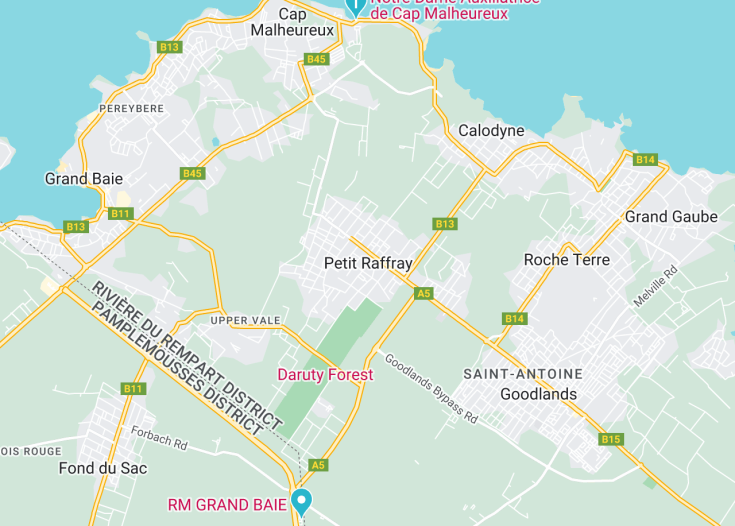Petit Raffray, nestled in the northern part of Mauritius, offers a tranquil escape from the bustling touristic areas, presenting a blend of natural beauty, local culture, and serene landscapes. This village, surrounded by lush greenery and scenic views, remains relatively untouched by commercial tourism, allowing visitors to experience a more authentic side of Mauritian life. The area is renowned for its hospitable locals, traditional Mauritian architecture, and is a gateway to exploring the vibrant ecosystems of nearby nature reserves.
For a truly local experience, visit Petit Raffray during the village festival held annually. It’s a perfect opportunity to enjoy local music, food, and traditions.
Travel light and wear comfortable shoes. Petit Raffray is best explored on foot, letting you discover its hidden charms and scenic spots at your own pace.
Top things to do & see in Petit Raffray
Select the following sights and activities to discover best tickets and tours available in Petit Raffray.
Petit Raffray: A Tranquil Escape in Mauritius
| Country | Mauritius |
| Time in Petit Raffray | GMT+4 |
| Language spoken | English and French |
| Population | 8,840 (World Population Review) |
| Currency | Mauritian Rupee (MUR, ₨) |
| Airports | Sir Seewoosagur Ramgoolam International Airport (37 mi / 60 km). |
Petit Raffray is a small village nestled in the northern region of Mauritius. Known for its serene environment and picturesque landscapes, it offers a unique blend of tranquility and local culture that attracts both tourists and locals alike. With a population of around 8,840 residents, this quaint destination provides a peaceful retreat from the busier parts of the island.
The innate charm of Petit Raffray is deeply rooted in its history of sugar cane plantations which play a significant role in the village’s identity. Today, while agriculture remains central, tourism has recently emerged, giving rise to small businesses and eco-touristic activities enhancing the local economy.
The village’s slow-paced lifestyle is dotted with friendly markets and artsy shops that offer local handicrafts. The green surroundings and fertile land make Petit Raffray a haven for outdoor enthusiasts who enjoy hiking and exploring lush trails. Moreover, its proximity to the coast means that stunning beaches are never far away, providing an easy escape to some of Mauritius’s most beautiful shores.
Petit Raffray also boasts a diverse cultural fabric. Influences from various communities including Creole, Indian, and European, are evident in daily life, particularly in its cuisine and festivals. Seasonal celebrations, bursting with color, music, and dance, provide a glimpse into the rich heritage and communal spirit of the area.
Where is Petit Raffray?
Located in the northern part of Mauritius, Petit Raffray is surrounded by lush landscapes and is close to the island’s picturesque northern beaches.
Distances:
| Route | Distance by car | Time by car |
|---|---|---|
| Port Louis to Petit Raffray | 15 miles (24 km) | 30 minutes |
| Grand Baie to Petit Raffray | 5 miles (8 km) | 10 minutes |
| Mahébourg to Petit Raffray | 42 miles (68 km) | 1 hour 15 minutes |
What is Petit Raffray famous for?
Petit Raffray is renowned for its lush green surroundings and traditional Mauritian lifestyle. It is a peaceful getaway spot with a strong community feel, making it a charming destination within Mauritius.
History
Early Settlements: Pre-18th Century
Before the 18th century, Petit Raffray, located in the northern part of Mauritius, was largely uninhabited, with only scattered settlements of the indigenous peoples. The lush landscapes and fertile soils were yet to be extensively cultivated, leaving the region largely pristine and dominated by native flora and fauna.
Colonial Era: 18th Century
During the colonial era, particularly under French rule starting in the early 1700s, Petit Raffray began to develop. The French settlers introduced sugar cane plantations to the area, transforming the local economy and landscape. The town was named after Charles Raffray, a notable French settler who contributed significantly to the region’s agricultural development.
British Rule: 19th Century
With the advent of British control in 1810, Petit Raffray continued to thrive as a sugarcane plantation hub. The British introduced more systematic agricultural practices and infrastructural developments, including roads and irrigation systems, which increased productivity and connectivity.
Post-Independence: 20th Century to Present
Since Mauritius gained independence in 1968, Petit Raffray has seen substantial development, transitioning from a predominantly agricultural society to a more diversified economy. Today, it is known for its blend of historical charm and modern residential growth, making it an attractive site for both local residents and international visitors.
Visit Petit Raffray
What to see and do in Petit Raffray, Mauritius
Explore the charming town of Petit Raffray, known for its scenic landscapes and rich history. Visitors can:
- Visit local sugarcane fields to learn about the historic backbone of the region’s economy.
- Explore the vibrant local markets, offering fresh produce and unique artisanal crafts.
- Take guided heritage tours to discover the architectural and historical landmarks of the area.
Festivals and Events in Petit Raffray
Experience the local culture through various events and festivals:
- Sugarcane Harvest Festival: Celebrated in late summer, this event showcases traditional harvesting techniques and local cuisine based on sugarcane.
- Petit Raffray Cultural Days: Occurring in mid-autumn, this event features music, dance, and art exhibitions that reflect the diverse cultural heritage of the region.
Best time to visit Petit Raffray
The best time to visit Petit Raffray is from May to November, when the weather is cooler and drier, ideal for exploring outdoor activities and attending local events.
Is Petit Raffray worth visiting?
Absolutely, Petit Raffray is worth visiting for anyone interested in experiencing a blend of historical charm and natural beauty. The town offers a unique glimpse into Mauritius’s colonial past, local culture, and the evolution of its agricultural practices. Whether you’re a history enthusiast, nature lover, or cultural explorer, Petit Raffray provides a rich and engaging experience.









